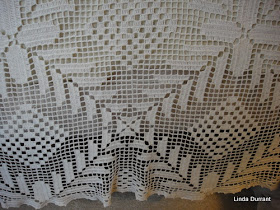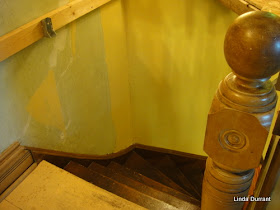Here's the front foyer door.
We're starting a new project. Repairing walls in the front foyer, walls going up the stairway, and down the upstair's hallway. I'm dividing this project into sections, beginning with the upstairs hallway.
The painted yellow walls in the foyer are in rough shape. While the plaster keys appear to be in good shape, the texture of the walls is rough as a cob. That's my Grandpa Bert's line, "rough as a cob". Makes me laugh because I can still hear him say it and see his smile. I wonder where Grandpa Bert heard that expression, and how many generations said it before him. I've heard my Dad use the expression too.
Detail of the Front Foyer Door
Original hardware on the front foyer door. The lock mechanism still works. Jon took apart the mechanism two years ago, cleaned it, and it with the skeleton key--works great.
Detail of mechanical door bell.
Check out the wood grain on the door. This is faux bois woodwork--a handpainted faux finish on pine by an artisan in 1893 to make the wood look like quarter sawn oak.
The doorways are also faux bois and and because of traffic over the years have chips in the faux bois paint, requiring touch up with a small artist brush. I use oil paints: yellow ochre, raw sienna, burnt sienna, burnt umber, and several artist brushes to make touch ups.
This is our very yellow foyer. To the left and right of the light fixture you can see golf ball size holes in the wall. That's where Jon blew insulation into the walls. The insulation made quite an impact on cooling, heating, and noise dampening.
The insulation was one of the first things done to the house in 2007 when we bought the house. Installation was very dirty work. We were able to move into the house in April 2008.
Above is a closet door in the foyer, located underneath the stairway. Again, all the woodwork is faux bois--handpainted to look like quarter sawn oak.
John Olson Wrolstad is the original owner/builder of our 1893 Queen Anne. John was a successful businessman in logging, and could have afforded expensive woodwork for his house. Instead he chose to have an artisan faux finish the pine woodwork throughout the house including the floors! Faux bois was all the rage in the 1800's.
The front foyer stairway
View from the base of the staircase
Ascending the stairs. Above is the temporary scaffold Jon built. The scaffold will help me repair the wall cracks.
Above, you can see the cleats supporting the temporary scaffold floor.
As we near the top of the stairs to the right you can see the cleat where a portable section of scaffold attaches to the wall.
At the left you can see the opposite cleat at the top of the stairs where a section of temporary scaffold floor can be added.
At the top of the stairs is the east hallway wall. Jon started to repair the cracks in the hallway sometime back. We are at a place now where we can continue repairs.
Once I am on the second floor landing I turn around to take photos of the temporary scaffold Jon built.
We hired Tom and Bev Lederhaus to finish the ceiling drywall installation, mudding, and sanding. Here are parts of the restoration that require more attention and ceonomical decisions. We did not rip out existing plaster and lathe but in some instances we've added new ceiling drywall to fight against new cracks, gravity, and furture maintenance.
You can see the temporary scaffold causes cosmetic damage to the stairwell walls which we will have to repair as we go along. Number 1 issue is safety, and so the scaffold fits the situation.
Laying across the scaffold platform is the second section with cleat. The cleat fits into the metal wall hangers. Next photo, you can see left and right--the metal hangers to hold the second scaffold section.
Below I'm standing in the north end of the hallway looking south to the upstairs bathroom we installed in May 2009.
View of the north end of the hallway landing. Beyond the etched glass door is a Juliet balcony. Last summer I started scraping the balcony but got distracted by another project--can't remember now exactly what it was.
For $200 I bought a pait of light fixtures for the hallway. You can't see the scrollwork etched into the glass shade, but it has similar etching as the etched glass door.
Here's the etched glass Juliet balcony door
The upstairs hallway is 28ft long, and at it narrowest about 5' wide.
Tom and Bev Lederhaus finished mudding and sanding the ceiling drywall July 14 this year. Two days later we hosted a tour of our house for the Voie Quien Reunion. The Quien family owned our house from 1917 until 2007. We purchased the house April 16, 2007.
Walking down the hallway to the new upstairs bathroom.
End of the hallway, entrance to the bathroom
We are so pleased with the upstairs bathroom. The door at the left is a huge walk in closet where we added a laundry room.
Just a reminder, below is a photo of the upstairs bathroom when it was just a storage room/small bedroom (Jan 2009).
Turning around now, and walking back to the stairway landing (looking north at the Juliet balcony door).
The east wall of the hallway. The brown painted line is decorative, but also shows where the picture rail might have hung. There is quite a bit of picture rail stored in the attic.
We are thinking about re-installing it.
So, as this project begins I'll track every suttle crack and secure it with web tape embedded with durabond. There are many cracks you can't see clearly in this photo. So let me give you an example of the number of wall cracks that were repairs in the west bedroom upstairs. You'll be surprised. See next photo.
Example: West Bedroom Upstairs During Repair of Wall Cracks (Dec 2008)
Example: West Bedroom Upstairs After Repairs of Cracks and Skim Coats (Jan 2009)
Above photo--descending the staircase
The pie shaped steps on the staircase
Traveling down the steps into the front foyer.
Peeling painted wallpaper (yellow); plaster painted green, and web tape embedded with durabond--beginning wall crack repairs.
Walking down the stairs, straight ahead are three golf ball size holes where Jon blewn in insulation.
The photographed light in the foyer makes it possible to see part of the Blue Heron etched glass front door.
Opening the front door - to show exterior view
How lucky are we? to have original doors, woodwork, and hardware
Here's a good photo of the etched glass front door
Imagine this. There are Five Doors in the front foyer. Two double doors here. One leads to the sitting room (living room), and the opened door here leads to the dining room.
I stopped to close the door to the dining room for this photo.
Now the door to the dining room is open again, and you can see a bit of the kitchen beyond the dining room. The door under the staircase is a closet. Across from the staircase (to the left) is another door (entrance to a parlor with pocket doors). Currently used as a bedroom.
I'd like to know more about these hangers in the wall at the base of the staircase. Can you tell me about them?














































































